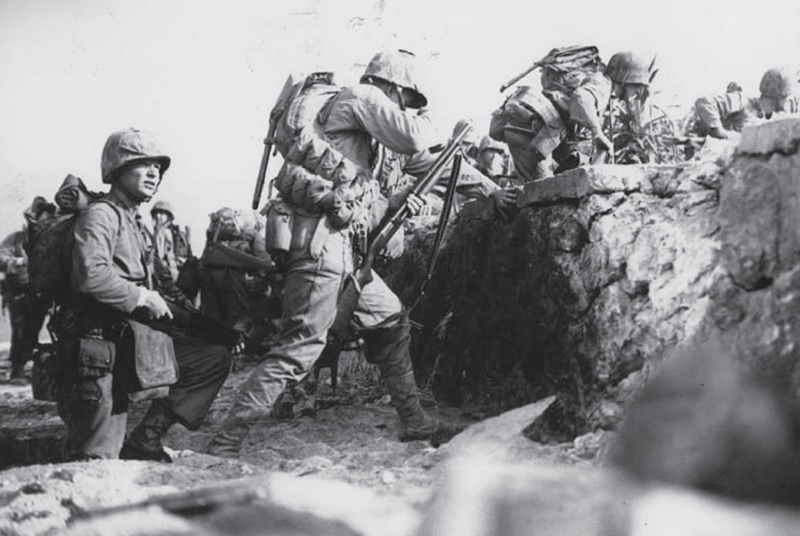Aside from a flame thrower, there are few close-range weapons as deadly as a shotgun. Shotguns are terrifyingly effective at short ranges, as their shot spread does not need to be precisely aimed to score a hit. At longer ranges, a shotgun peppers the target with fast-moving metal balls, while at close ranges shotguns can effortlessly inflict horrific wounds. For these reasons, the shotgun has found itself at home in close quarters combat in wartime, sometimes controversially. Until the 1960s the United States’ shotguns of choice have been the Winchester Model 1897 and 1912.
Both of these shotguns started life as commercially-sold firearms but quickly proved themselves on the battlefield.
Model 1897

The first of these was the Model 1897. This pump-action shotgun was produced by the Winchester Repeating Arms company and set the standard for which all shotguns that followed were measured against. As its name suggests it was introduced in 1897. Amazingly, this weapon stayed in production until 1957, with over 1 million being built in total. This makes the Model 1897 one of the most successful pump-action shotguns of all time.
Despite being manufactured by Winchester, the Model 1897 was actually designed by the legendary and massively influential gun designer John Browning. It was an improvement on the Model 1893 shotgun – also designed by Browning – that could fire smokeless powder shells and be broken down into individual parts.
With this “take down” ability the 1897’s barrel and magazine could be completely removed, which made transportation and maintenance easier. The concept of a removable barrel is now standard for pump-action shotguns.
The gun came in either 16 or 12 gauge and with a number of different barrel lengths, ranging from 20 to 36 inches. One of the 1897’s most noticeable design features is its external hammer, which protrudes out of the back of the receiver when the pump is slid back to cycle the gun. This action ejects the spent shell, cocks the hammer, and pushes a new shell into the chamber. Interestingly, this shotgun lacks a trigger disconnector, which means if the trigger is held down, the gun will fire as soon as the pump returns to its home position. Because of this the Model 1897 can be fired at very high speeds.
The Model 1897’s first use in combat was with US troops in the Philippine-American War of 1899. Not only was it the weapon’s first time in war, but it was also the first shotgun issued by the US military on a large scale. However, the 1897 rose to fame after America joined the First World War.
Realizing that rifles were not suited to the extremely close-quarters fighting happening in the trenches of the Great War, the US brought in the Model 1897 for these exact circumstances. For trench use, pre-existing Model 1897’s were modified with a perforated heat shield that covered the barrel – stopping the user from burning their hands – and a bayonet lug. In this form, the weapon was known as the Trench Gun.
Its high fire rate, devastating power, and 20-inch barrel made it extremely good at clearing trenches. Reportedly, experienced trap shooters in the ranks were given Model 1897s and blasted enemy grenades out of the air.
The shotgun was so deadly that Germany famously protested against its use, stating it caused “unnecessary suffering”. This was an interesting view coming from a country that fielded chemical weapons. As the Germans claimed that the shotgun broke the 1907 Hague Convention on Land Warfare the US took the situation seriously. When they determined there was no foul play involved, Germany responded with threats to punish any captured American shotgun-users.
The Model 1897 was once again used in WWII, and even in Vietnam in limited numbers. By this time though it had been mostly replaced by the Model 1912.
Model 1912

The Model 1912 succeeded the Model 1897 in much the same way the Model 1897 did to the 1893. Although this time the weapon was designed by T.C. Johnson, not Browning. As an evolutionary next step from the Model 1897, the Model 1912 had an internal hammer but retained the same pump-action and ability to fire when the action was closed. Starting production in 1912 and ending in 1964, almost 2 million Model 1912s were built.
Like its predecessor, this shotgun was used in WWI, WWII, Korea, and Vietnam, where it was also given a perforated heat shield and bayonet lug. The weapon was mainly used in the Pacific theatre of WWII by US Marines against the Japanese, once again to great success. Deadly, reliable, and compact, it was perfectly suited to clearing Japanese positions and bunkers.
The Model 1912 was a sturdy, well-engineered weapon that, along with the 1897, set the standard for shotgun designs. However, by the 1960s this relatively expensive shotgun was simply unable to compete with newer, cheaper designs from rival manufacturers. For this reason, the Model 1812 was discontinued in 1964, seven years after the Model 1897.
